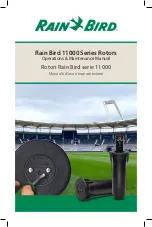
18
4. Compare the hi-pressure reading to the “Required Liquid
Line Temperature” chart. Find the hi-pressure value on the
left column. Follow that line right to the column under the
design subcooling value. Where the two intersect is the
required liquid line temperature.
Alternately you can convert the liquid line pressure gauge
reading to temperature by finding the gauge reading in
Temperature
- Pressure Chart and reading to the left, find the
temperature in the °F. Column.
5. The difference between the thermometer reading and
pressure to temperature conversion is the amount of
subcooling.
Subcooling Formula = Sat. Liquid Temp. - Liquid Line Temp.
EXAMPLE:
a. Liquid Line Pressure = 417
b. Corresponding Temp. °F. = 120°
c. Thermometer on Liquid line = 109°F.
To obtain the amount of subcooling, subtract 109°F from 120°F
The difference is 11° subcooling. See the specification sheet or
technical information manual for the design subcooling range for
your unit.
See R410A Pressure vs. Temperature chart.
Cooling Refrigerant Charging (Models with TXV)
Check unit charge before putting the cooling section into
full operation. The unit has a thermostatic expansion valve
metering device. To ensure the unit is properly charged for the
intended application, check the unit refrigerant sub-cooling at the
condenser. The refrigerant sub-cooling is a function of outdoor
ambient temperature and return air temperature of the conditioned
space. It is the installing contractors responsibility to ensure the
proper refrigerant sub-cooling at the condenser is adjusted for
each application. As the outdoor ambient temperature rises the
sub-cooling decreases and as the outdoor ambient temperature
lowers, the sub-cooling increases.
NOTE:
Proper sub-cooling adjustment optimizes cooling
performance. Models equipped with thermostatic expansion valve,
charge the system to sub-cooling, range shown on chart, when
necessary, adjust expansion valve stem for superheat setting.
NOTE:
The expansion valve will not need adjustment for most
applications. Ensure system superheat is set within range listed
on chart.
DP16UM3008041
8 - 12
8 - 12
10 - 14
DP16UM3608041
10 - 14
Superheat °F
3 - 7
4 - 8
4 - 8
2 - 6
9 - 13
DP14UM610804*
DP14UM300604*
DP14UM360604*
DP14UM360804*
DP14UM480804*
8 - 14
9 - 15
8 - 14
Subcooling °F
12 - 18
8 - 14
DP14UM240404*
10 - 14
8 - 14
DP14UM420804*
8 - 12
9 - 15
Models #
Design superheat & subcooling @ 95 °F outdoor ambient
temperature
Superheat Adjustment
To adjust superheat, remove the control box cover and locate the
expansion valve on the liquid line of the evaporator. Unscrew the
cover from the expansion valve, locate the adjustment screw, and
turn it clockwise (in) to increase superheat or counterclockwise
(out) to decrease superheat. Replace adjustment cap. Wait a
minimum of 10 minutes between adjustments to allow time for the
TXV and pressures to stabilize.
Cooling Operation
NOTE: Mechanical cooling cannot be reliably provided at ambient
temperatures below 50° F.
1. Turn on the electrical power supply to the unit.
2. Place the room thermostat selector switch in the COOL
position (or AUTO if available, and if automatic changeover
from cooling to heating is desired).
3. Set the room thermostat to the desired temperature.
Troubleshooting
Ignition Control Error Codes
The following presents probable causes of questionable
unit operation. Refer to Diagnostic Indicator Chart for an
interpretation of the signal and to this section for an explanation.
Remove the control box access panel and note the number of
diagnostic LED flashes. Refer to Diagnostic Indicator Chart for an
interpretation of the signal and to this section for an explanation.
Fault Recall
The ignition control is equipped with a momentary push-button
switch that can be used to display on the diagnostic LED the last
five faults detected by the control. Any time the control is powered,
the fault code history can be retrieved for display by depressing
and releasing the button once (less than 5 seconds); the LED
will flash the Fault Code History (up to 5 fault codes from newest
to oldest). The Fault Code History is retained between power
cycles until cleared. A fault code is added to the history log as it
is encountered if it differs from the most recent history log item. If
the history log is already full, then the oldest entry is dropped from
the log and the remaining entries are moved down in the Fault
Code History so that the new fault can be added to the Fault Code
History as the most recent fault.
NOTE:
Do not hold for longer than 5 seconds. Holding the button
for 5 seconds or higher will erase the memory!
Resetting From Lockout
An external lockout occurs if the integrated ignition control
determines that a measurable combustion cannot be established
within three (3) consecutive ignition attempts. If flame is not
established within the four (4) second trial for ignition, the gas
valve is de-energized, 30 second inter-purge cycle is completed,
and ignition is re-attempted. The control will repeat this routine
three times if a measurable combustion is not established. The
control will then shut off the induced draft blower and go into a
lockout state.
If flame is established but lost, the control will energize the
circulator blower at the heat speed and then begin a new ignition
sequence. If flame is established then lost on subsequent
attempts, the control will recycle the ignition sequence.
Summary of Contents for DP14U Series
Page 23: ...23 APPENDIX Unit Dimensions...
















































